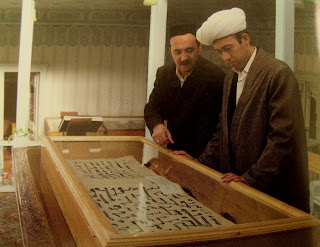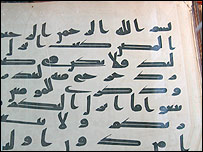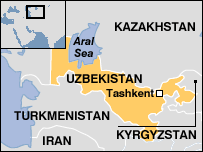@
Jazzbot @
jaibi @
danish falcon @
Alpha1.... no contribution

??
Quran is the only "book" that all Muslims believe is "unchanged" & "perfect" , And as discussed earlier , there are enough reasons to believe in this ....
Now the question arises that despite believing in One Allah , Same Quran & One Prophet (pbuh) , Why do the Muslims kill each other in the name of the same religion (i.e Islam) which they all follow ???
The answer seems to be very simple , They believe in different collections of
Ahadith (sayings attributed to prophet pbuh) , often highly contradicting, and they follow different versions of the `same` Islamic History ...
But things might not be that simple , The first Islamic civil war (656-661 CE) , also known as the First Fitna , was fought among the Muslims who did not follow different Ahadith or versions of history , They were mostly companions and relatives of the prophet (pbuh) who had learnt Islam directly from the Messenger of Allah !! They did not challenge each other`s faith , They contested for the leadership of the newly born Ummah .. The divide in the Muslims was purely "political" in the beginning , which became "religious" with the passage of time . Ali (r.a) was a cousin and son in law of Muhammad (pbuh) , who fought against Aisha (r.a) [ the beloved wife of prophet (pbuh)] and Zubair bin Awwam (r.a)[also a cousin of prophet as well as Ali himself] in 656 AD , in the "battle of camel" .. Later Ali r.a had to fight Muaviyyah in "battle of siffeen" , Muaviyyah was brother in law of Muhammad (pbuh) and a distant cousin .. So the participants of the First Fitna were all related to each other , and no one tried to prove his superiority over the other claiming a kinship to Muhammad (pbuh) and "religion" stayed out of politics ..
But in the Second Islamic Civil war (ended 692 AD) , the religion could not stay out of politics . Following the Murder of Imam Hussain and almost all the male members of family of prophet (pbuh) in "battle of kerbala" by the Ummayad troops of Yazid (son of Muaviyyah) in 680 AD(The battle is often cited as the definitive break between the Shi'a and Sunni sects of Islam) , Yazid faced a second revolt from Abd Allah ibn al-Zubayr, who was the son of al-Zubayr ibn al-Awwam and the son of Asma bint Abu Bakr. Ibn al-Zubayr's rebellion was seen by many as an attempt to return to the pristine values of the early Islamic community, and his revolt was welcomed by a number of parties that were unhappy with the Umayyad rule for various reasons.
This was the first time that the name of "Muhammad" was used for political purposes . As is evident from archaeological record , The name of Muhammad was not minted on coins or other inscriptions before Abdullah Bin Zubair gained control of Hijaz . The oldest coins with shahada of prophethood of Muhammad (pbuh) are from his time . His opponent and the Ummayad leader Abdul Malik , followed him and started using the name of prophet on coins and other inscriptions (a practice his predecessors never approved of) .
He went on to build a alternative ka`ba in jerusalem as the Ummayads had lost control of Makkah ; The famous Dome Of The Rock , and this was the time when he ordered compiling of Ahadith for political purposes , something forbidden by the messenger of Allah and the Khulfa e Rashideen , ....
al-Ya`qubi writes is in his
Tareekh :
`Abd al-Malik prevented the people of Sham from the hajj and this is because Ibn al-Zubayr was taking the pledge of allegience from the pilgrims. When `Abd al-Malik had found out about this, he prevented them from setting out to Makkah. But the people protested and said: "Do you prevent us from doing the pilgrimage to the Sacred House of Allah while it is a duty from Allah upon us ?" He said: "Here is Ibn Shihabuddin al-Zuhri narrating to you that the Messenger of Allah said: "The caravans should not be set out except for three mosques, the Sacred Mosque, my present Mosque and the Mosque of Jerusalem" [which] stands for the Sacred Mosque for you. And here is the Rock on [which] it is narrated that the Prophet set his foot before ascending to the heavens, it stands for the Ka`bah. Then he built a Dome on the Rock, suspended silk curtains on it and appointed servants for it. And told the people to revolve around it like they revolve around the Ka`bah and so it was during the rule of Bani Umayyah( Ahmad b. Abu Ya`qub Ibn Wadih al-Ya`qubi (Ed. M. T. Houtsma), Tarikh, 1883, Volume II, Leiden, p. 311)
Now we have two options
1) Reject this allegation saying that Al Yaqubi was a Shia and this is anti ummayad propaganda , or
2) Try to further investigate into it and see if this claim is backed by other sources or historical records
Going by option number 2 , lets see what some orientalists have to say
In the passage of his
Muhammedanische Studien,
Goldziher puts forward in detail the theory that Umayyad caliph
`Abd al-Malik, by erecting the
Dome of the Rock in Jerusalem, intended to outsmart his rival `Abdallah b. al-Zubayr, who exploited the holiness of Makkah, his capital, for his own political ends. Goldziher wrote:
When the Umayyad Caliph `Abd al-Malik wished the stop the pilgrimages to Mecca because he was worried lest his rival `Abd Allah b. Zubayr should force the Syrians journeying to the holy places in Hijaz to pay him homage, he had to recourse to the expedient of the doctrine of the vicarious hajj to the Qubbat al-Sakhra in Jerusalem. He decreed that the obligatory circumambulation (tawaf) could take place at the sacred place in Jerusalem with the same validity as that around the Ka`ba ordained in Islamic Law. The pious theologian al-Zuhri was given the task of justifying this politically motivated reform of religious life by making up and spreading a saying traced back to the Prophet, according to which there are three mosques to which people may make pilgrimages: those in Mecca, Medina and Jerusalem.(I. Goldziher (Ed. S. M. Stern), Muslim Studies (Muhammedanische Studien), 1971, Volume II, Atherton: New York and Aldine: Chicago, pp. 44-45.)
Goldziher's theory had been adopted, uncritically or with some criticism, by many early orientalists and a few recent ones; some of them are Creswell ,Rippin , van Ess,and Elad.
Now again these are western sources and most of the Muslims will not be willing to accept them , lets try to find out what Muslims (Only Sunnis) have to say on this ...
Before going into details , One should know that who was
Ibn e Shihab Al Zuhri as he is the one being accused of writing fabricated Ahadith for the Ummayad rulers ..
Ibn Shihab al-Zuhri(d. 742 AD) i
s regarded as one of the greatest Sunni authorities on Hadith. The leading critics of Hadith such as
Ibn al-Madini, Ibn Hibban, Abu Hatim, Al-Dhahabi and
Ibn Hajar al-Asqalani are all agreed upon his indisputable authority . He can also be regarded as
the first Historian of Islam
Ibn Shihab al-Zuhri was the first one to compile Ahadees [fath ul bari by ibne hajar]
Imam Malik (d. 179) said, "The first one to utilise the isnad was Ibn Shihab al-Zuhri" [Ibne abi Hatim Al Razi, aljarrah wa altadeel p.20 vol 1]
So Ibn e Shihab Zuhri is actually the founding father of "Hadith Science" and the first one to compile Ahadith ..
Al Zuhri is a main narrator of both , Sahih Muslim and Sahih Bukhari (around 1700 ahadith from him in both)
Challenging his authority is challenging the whole "Science of Hadith" , and Al Yaqubi has accused him of writing fabricated Ahadith , so Al Yaqubi can very well be a Shia...
But Wait ...
Is he the only one who has accused Al Zuhri of Tadlees (hadith fabrication) ??
The answer is definitely "No"
Zuhri’s Tadlis is recorded in the following words:
Imam Shaf‘i, Dara Qutani and many others have attributed Tadlis (Hadith Fabrication) to Zuhri. (Ibn Hajar, Tabaqatu’l-Mudallisin, [Cairo: Maktabah Kulliyyat al-Azhar], pps. 32-3)
Imam Malik also did not consider Al Zuhri trustworthy and thats why he does not narrate Zuhri`s solo traditions in his famous hadith collection "Muwatta"
Some of the greatest Sunni scholars of all times did not consider Al Zuhri to be trustworthy
Then why blame Al Yaqubi alone ???
And .....
Al-Zuhri himself is reported to have said: ‘We disapproved of recording knowledge [meaning hadith] until these rulers forced us to do so. After that we saw no reason to forbid Muslims to do so.’” (Ibn Sa’d, Tabaqat, II, ii, p. 135)
Ibn e Saad is definitely a Sunni !! This confession by Al Zuhri himself is enough as a evidence when considered alongwith other similar reports
Ibne Shihab al-Zuhri was the first historian who wrote the history of Islam under the direct order and fund of Abdul Malik. He also wrote Hadith collection. The works of al-Zuhri was one of the main source for al-Bukhari. al-Zuhri was attached to the royal family of Abdul Malik, and was the tutor of his sons. (al-Sirah al-Nabawiyyah," by Shibli part I, pp.13-17)
Shibli is also a "great" sunni historian
Among the students of al-Zuhri, two persons, namely
Musa Ibn Uqbah, and
Mohammad Ibn Ishaq became famous historians. The former was a slave of the house of Zubair. Although his history is not available today, it had been the most popular work on history for a long time. You will find its references in many history books on different subjects.
The second student, Mohammad Ibn Ishaq is the most famous historian . His biography of the Prophet, called "Sirah Rasul Allah", is still the accredited authority on the subject in the shape that was given to it by Ibn Hisham, and is known as "al-Sirah of Ibn Hisham".
So Islamic Hadith and History books were first compiled under the direct order of Umayyah Kings for political purposes .............
And for those who think that prophet(pbuh) did not prohibit writing down Ahadith :
Abu Sa'id Khudri reported that Allah's Messenger (may peace be upon him) said: Do not take down anything from me, and he who took down anything from me except the Quran, he should erase that and narrate(orally) from me, for there is no harm in it and he who attributed any falsehood to me-and Hammam said: I think he also said:" deliberately" -he should in fact find his abode in the Hell-Fire (Sahih Muslim, Book 042, Chapter 17, Number 7147).
There are other similar hadith reports, e.g., one from Abu Dawud, and another from Taqyid by al-Baghdadi confirming the Prophet’s prohibition on hadith writing and direction for erasure of any hadith.[
www.mostmerciful.com/hadithbook.]
According to one report, the first Caliph Abu Bakr burned his own notes of hadith (said to be some 500), after being very uneasy about these notes.[ Rahim, M. Abdur, The History of Hadith Compilation (in Bengali), p. 290, quoted by Jamilul Bashar, “Sangsker” (in Bengali, means Reformation), published by Young Muslim Society, New York, 2002, pp. 11.]
During the caliphate of Umer r.a, “the problem of hadith forgery was so serious that he prohibited hadith transmission altogether.”[ Brown, Daniel W., 1996 (paperback 1999), op. cit., p. 96.]
So one can safely conclude
1) Prophet (pbuh) and Khulfa e Rashideen did not allow writing down of Ahadith
2) Ibn e Shihab was the first one to violate the sunnah of prophet
3) The Ummayad Rulers forced Ibn e Shihab Al Zuhri to write fabricated ahadith , which Zuhri did not want to write down
And
Allama Muhammad Iqbal has described this in folowng words :
Iqbal notes in his seminal work The Reconstruction of Religious Thought in Islam,
even Abu Hanifah, regarded as “one of the greatest exponents of Muhammedan Law in Sunni Islam … made practically no use of … traditions”, even though there were collections available at that time made by other people no less than thirty years before his death. Nor did he collect any hadith for his use, unlike his peers Malik and Ahmad Ibn Hanbal.
Thus, according to Iqbal, “if modern Liberalism considers it safer not to make any indiscriminate use of them [Ahadith] as a source of law, it will be only following [the example of Abu Hanifah].”
[Iqbal, A. M., The Reconstruction of Religious Thought in Islam, First Indian Edition 1997, p. 137.]



























































